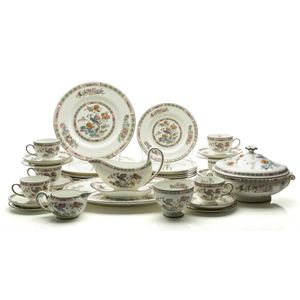
Wedgwood 'Kutani Crane' 6 Person Dinner Suite Set
A Wedgwood 'Kutani Crane' pattern six person dinner suite, Comprising-, 6x dinner plates, 6x entree plates, 6x cake plates, 1x gravy boat and saucer, 6x teacups and saucers, 1x lidded tureen, 1x oval platter, 1x sugar bowl, 1x creamer

Wedgwood 'Runnymede' Partial Dinner Service - 28 Pieces
A Wedgwood 'Runnymede' patterned partial dinner service, Comprising-, 6x dinner plates, 7x entree plates, 5x soup bowls, 7x bread plates, 1x square serving platter, 1x coffee pot, 1x tea pot, 2x creamers, 1x sugar bowl and saucer, 2x twin handled coupes,…
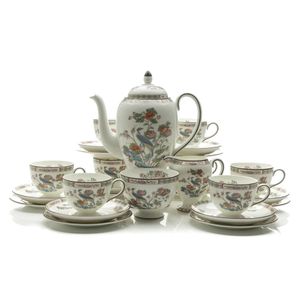
Wedgwood Kutani Crane Tea Set: Teapot, Creamer, Sugar Bowl, Trios
Wedgwood porcelain Kutani crane pattern tea suite, comprising;, 1 x teapot, 1 x creamer, 1 x sugar bowl, 8 x trios

Wedgwood 'Pennine' Dinner Service Set - 40 Pieces
A Wedgwood 'Pennine' pattern dinner service, comprising 1 x coffee pot, 1 x teapot, 1 x creamer, 1 x sugar pot with lid, 1 x oval tureen, 1 x small round tureen, 6 x shallow bowls, 9 x coffee mugs & 8 saucers, 13 x bowls, 16 x side plates, 28 x dinner…

Wedgwood 'Gold Columbia' Partial Dinner Set - 21 Pieces
A Wedgwood 'Gold Columbia' partial dinner suite, comprising 6x coupes, 1x teapot, 1x sugar bowl, 4xCoffee cups & 3x saucers, 4x saucers, 3x saucers, 5x cake plates, 2x entree plates, 6x dinner plates.

19th Century Wedgwood Jasper Ware Bachelor Tea Set with Tray
Wedgwood antique English Jasper Ware bachelor tea set comprising of a teapot, milk jug, sugar basin, teacup, saucer and plate plus tray, 19th century, (7 items), impressed 'Wedgwood', the tray 34 cm wide

Wedgewood majolica leaf serving dish with candle holder and shakers
A Wedgewood majolica leaf form serving dish, width 27 cm together with candle stick holder and salt and pepper shakers

Wedgwood 'Kutani Crane' Bone China Tea Set Collection
Wedgwood 'Kutani Crane' bone china tea set. Comprising;, 1 x teapot, height 13 cm, 1 x milk jug, 1 x sugar bowl, 1 x scalloped edged clover leaf triple tray, 1 x leaf shaped petit four serving tray, 1 x large sandwich plate, diameter 24 cm, 6 x bread and…
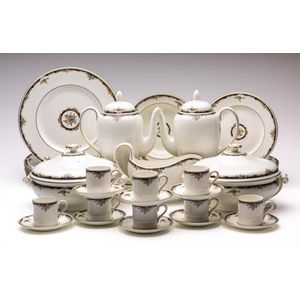
Wedgwood 'Osborne' Dinner and Coffee Set with Accessories
Wedgwood 'Osborne' dinner set together with coffee set. Comprising, 1 x sugar bowl, 1 x creamer, 1 x gravy boat with saucer, 1 x oval bowl, 1 x small butter plate, 1 x oval serving platter, 2 x coffee pots, height 26 cm, 8 x coffee trios cup, under plate,…

Wedgwood Capri Ware urn and sugar sifter, 19th-20th century
Wedgwood 'Capri Ware' pottery urn with floral enamel decoration, early 19th century, impressed 'Wedgwood', 13 cm high;, together with a pottery sugar sifter with silver plated top, circa 1900, (2 items)

Vintage Wedgwood Etruria & Barlaston Celadon Dinner Service Set
A vintage Wedgwood, England of Etruria & Barlaston celadon dinner service, including 12 dinner plates, 6 side plates, 5 large saucers, 4 soup coupes, 7 tea cups & saucers, 1 teapot, 1 sugar bowl & 1 creamer,

Wedgwood 'California' 16-Piece Dinnerware Set
Wedgwood 'California' four-person dinner suite, 1 x tea/coffee pot, 1 x creamer, 1 x sugar bowl, 4 x duos, 4 x bowls diameter 15.5 cm, 4 x small plates diameter 21 cm, 4 x dinner plates diameter 27 cm
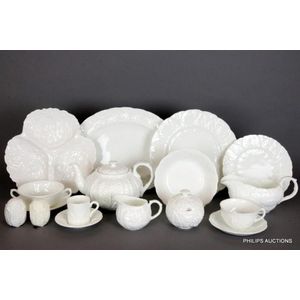
Wedgwood & Coalport 'Countryware' 116-Piece Dinner & Tea Service
A Wedgwood & Coalport 'Countryware' dinner & tea service, the extensive 116-piece white leaf moulded mixed service comprising 24 dinner plates, 12 side plates, 12 bowls, 6 soup coupes, 8 large oval serving plates and 2 small ones, 2 lidded tureens, 3…

Wedgwood 'Carisbrooke' Tea Suite: 8 Trios, Plates, Teapot, Serving Plates
A Wedgwood 'Carisbrooke' patterned tea suite comprising: 8 teacup, saucer and underplate trios, 8 side plates, 2 dinner plates, 1 pin dish, 1 teapot, 1 sugar, 1 creamer, 2 oval serving plates, length 24 cm,

Wedgwood 'Columbia' 8-Person Dinner Service
A Wedgwood 'Columbia' eight person dinner service, consisting of 8 dinner plates, 8 entree plates, 8 side plates, 8 bowls, 8 saucers, 9 cups, 1 gravy boat and saucer, 1 sugar, 1 creamer,
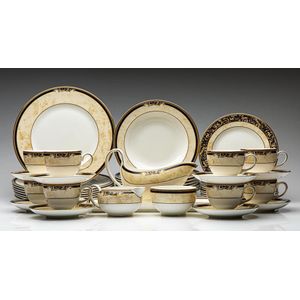
Wedgwood 'Cornucopia' 8-Person Tea and Dinner Set
An eight person Wedgwood 'Cornucopia' tea and dinner suite, comprising, 8 teacup, saucer and underplate trios, 8 dinner plates, 8 bowls, 8 side plates, 1 gravy boat and saucer, 1 sandwich plate, 1 creamer, 1 open sugar,
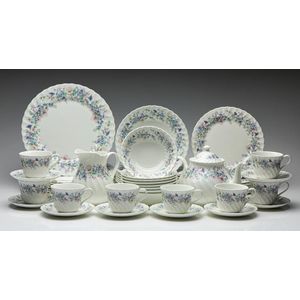
Wedgwood 'Angela' 8-Person Tea & Dinner Set
A Wedgwood 'Angela' patterned tea and dinner suite for eight persons, comprising, 8 teacup, saucer and underplate trios, 8 dinner plates, 8 bowls, 8 smaller bowls, 8 side plates, 1 teapot, 1 open sugar, 1 creamer, 1 gravy boat and saucer, 1 basket dish, 1…

Vintage Wedgwood Tea Service with 33 Pieces
A vintage Wedgwood, England 'Etruria vieux Rouen' tea service, including a cake plate, a sugar bowl, a creamer, twelve side plates, twelve saucers, five teacups
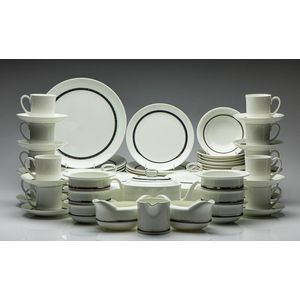
Suzy Cooper Wedgwood Dinner Set
Suzy Cooper for Wedgwood dinner service, comprising 12 dinner plates, 13 bowls, 13 teacups and 12 saucers, 13 coupes and 12 saucers, 11 bread and butter plates, 13 entree plates, 2 tureens, 1 teapot, 1 lidded sugar pot, 1 creamer, 2 gravy boats, 2 oval…
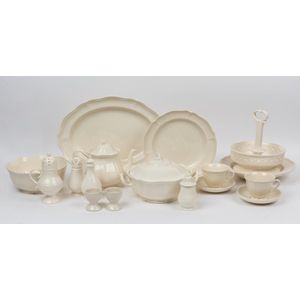
Wedgwood Queensware Dinner Service for Eight with Extras and Stand
A comprehensive Wedgwood Queensware dinner service for eight place settings with extras, together with a matching Leedsware stand, comprising over one hundred pieces including dinner, entree and side plates, pasta or soup bowls, shallow bowls and dessert…

Wedgwood Majolica Vine Leaf Cruet Set
A Wedgwood Majolica vine leaf cruet set, includes salt & peper, mustard pots, vinegar bottle

Wedgwood Gold Florentine 6-Person Tea and Dinner Set
A Wedgwood six person 'Gold Florentine' patterned tea and dinner suite comprising 6 teacup and saucer trios - hairlines to one small saucer, 6 bowls, 6 bread and butter plates, 6 dinner plates, 1 sugar bowl, 1 creamer

Wedgwood 'Sarah's Garden' Tableware Set
A Wedgwood 'Sarah's Garden' table suite comprising: 9 large bowls, 12 smaller bowls, 12 dinner plates - two chipped to rim, 12 tea cup and saucer trios - one large saucer chipped to underside, 1 lidded sugar pot, 1 twin handled vase, height 17.5 cm, 1…

Wedgwood 'Amhurst' Dinner Service for Eight
A Wedgwood 'Amhurst' dinner service for eight persons consisting of;, 8 dinner plates, 8 entree plates, 8 bread plates, 8 coffee cups with saucers, 8 tea cups with saucers, 8 dessert bowls, 14 soup bowls, 2 serving platters, 4 vegetable dishes, 2 lidded…

Wedgwood 'Flying Cloud' Dinnerware Set for Eight
Georgetown collection by Wedgwood 'Flying Cloud' coffee and dinner suite for eight from an original Wedgwood engraving, comprising 8 tea cup and saucer trios, 8 coupe duos one coupe has chip to rim and another a chip to foot, 8 bowls, 8 dinner plates, 8…
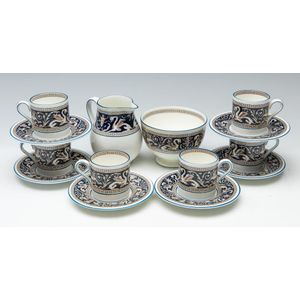
Wedgwood 'Florentine' Coffee Set with 6 Duos, Sugar & Creamer
A small Wedgwood 'Florentine' patterned coffee suite comprising 6 duos, sugar bowl and creamer

Wedgwood Black Basalt Sugar Bowl & Cream Jug Set
Wedgwood black basalt sugar bowl & cream jug each with embossed classical decoration, marked to bases, height 13 cm, jug.
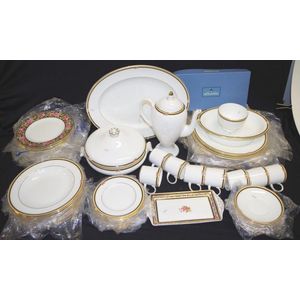
Wedgwood 'Clio' Dinner & Coffee Set
Extensive Wedgwood 'Clio' dinner service comprising: 12 dinner plates, 17 entree plates, 10 soup bowls, 12 side plates, sandwich plate, oval serving bowl, lidded vegetable tureen, large serving platter, and coffee set, comprising: 8 coffee cups and…

Imari Wedgwood Tea Set with Repairs
A suite of Wedgwood Imari tea wares comprising teapot, lidded sugar, creamer, six duos, hairline to one cup; significant repair to one saucer
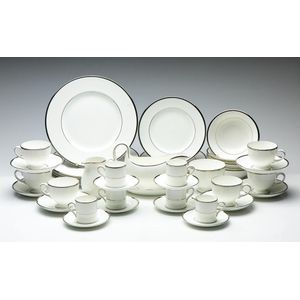
Wedgwood 'Carlyn' Tea and Dinner Set for Six
A Wedgwood 'Carlyn' tea and dinner suite for six comprising 6 dinner plates, 6 side plates, 6 bowls, 6 duos, chip to one teacup rim, 6 demitasse trios, 1 creamer, 1 lidded sugar, 1 tureen, 1 gravy boat and saucer, 1 oval shallow bowl, 1 oval serving…

Wedgwood Etruria Suite: Comport, Leaf Dish, Small Dishes, S&P
A Wedgwood of Etruria suite of ceramics including. Comport, width 32 cm, leaf dish width 37 cm, five small dishes and a salt and pepper

Wedgwood Black Basalt Demi Service with 11 Pieces
Wedgwood black basalt demi service, 2 coffee pots, sugar, creamer, 11 cans and saucers

Wedgwood Black Basalt Tea Set (4 pieces)
Wedgwood black basalt four pieces, teapots, sugar and creamer (4)

Basalt Urn, Sugar Basin, Bisque Spill Vases & Provenance
A black basalt urn and a covered sugar basin and a pair of Continental bisque spill vases, the basalt ware probably Wedgwood. Provenance: The property of a gentleman, Sydney.

Wedgwood Kutani Crane Coffee Set with 8 Cups
Wedgwood 'Kutani Crane' coffee set R4464, including lidded coffee pot, cream jug, and lidded sugar bowl, and 8 coffee cups and saucers.
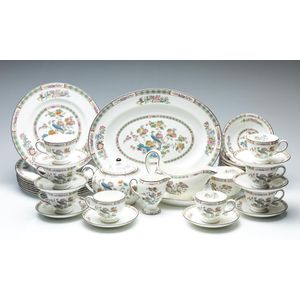
Wedgwood Kutani Crane Tea and Dinner Service for Eight
A Wedgwood 'Kutani Crane' tea and dinner service for eight comprising 8 trios, 8 bread plates, 8 dinner bowls, 1 gravy boat and saucer, 1 creamer, 1 sugar bowl, 1 teapot, 1 oval serving plate, 8 small bowls
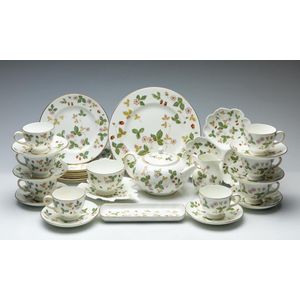
Wild Strawberry Wedgwood Tea Set for Eight
A wild strawberry patterned Wedgwood tea suite for eight people comprising 8 teacups, 8 saucers, 1 creamer, 1 sugar bowl, 1 teapot, 1 leaf plate, 1 small rectangular dish, 1 condiment dish, 8 side plates, 1 dinner plate

Wedgwood Green Leaf Condiment Set, 20th Century
Wedgwood green leaf patterned four piece condiment set, 20th century, circular black factory mark to base, the tray 17 cm wide
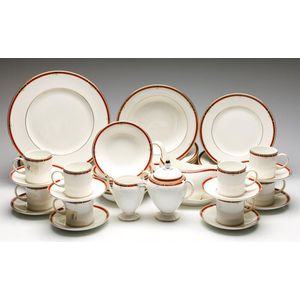
Wedgwood Colorado Dinner Set for Eight
A Wedgwood 'Colorado' pattern dinner suite for eight Including, 8 trios, 1 chip to edge of small saucer, 8 small bowls, 8 larger bowls, diameter 23 cm, 8 bread plates, 8 dinner plates, 2 oval serving bowls, length 24.5 cm, 1 oval serving dish, length 35.5…

Wedgwood Jasperware Trio: Sugar, Mustard, Pepper
Three pieces of Wedgwood Jasperware, comprising sugar bowl, mustard pot and pepper shaker, (3)
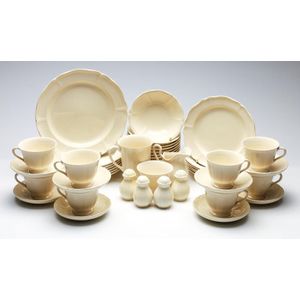
Wedgwood 'Queens Plain' Dinner Service
A large Wedgwood 'Queens Plain' dinner service including: nine teacups, eight saucers, one large mug, eight bowls, six cake plates, six bread plates, seven dinner plates, one creamer, Ond round platter, diameter 30.5 cm, one oval platter, width 39 cm, one…

Clarice Cliff Wedgwood Sugar Casters, Centenary Collection
A pair of Wedgwood Bizzare by Clarice Cliff sugar casters, the Centenary collection, circa 1999, with series and black transfer printed factory marks to the base, 14 cm high (each)

Wild Oats Coffee Set by Wedgwood
Wedgwood 'Wild Oats' coffee set including: 6 coffee cups and saucers, lidded sugar bowl, cream jug, and coffee pot.

Wedgwood 'Ascot' Dinner Service Set
A Wedgwood 'Ascot' part dinner service consisting of 9 dinner plates, 3 smaller side plates, 6 bread plates, 1 coffee pot, one teapot, 1 sugar, 1 creamer, 2 serving trays, 1 serving salad bowl, 8 coupes, 8 coffee cups, 9 larger saucers, 6 smaller saucers,…
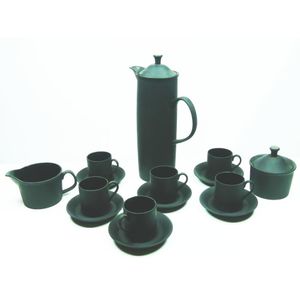
Wedgwood Black Basalt Coffee Service Set
Wedgwood coffee service a black basalt ware service consisting of six coffee cups and saucers, sugar bowl, milk jug and coffee pot.

Wedgwood 'Florentine' Part Dinner Set
Wedgwood 'Florentine' part dinner set marked to bases and # W1956, including 8 dinner plates, 8 soup coupes and 5 under saucers, 7 cups and 7 saucers, 8 side plates, 8 coffee cups and 6 saucers, 6 dessert bowls, a lidded sugar bowl, and cream jug.

Victorian Wedgwood Lazy Susan with Floral Design
Large Victorian Wedgwood porcelain Lazy Susan, footed form with brass two division cruet stand to the top decorated with allover floral design in blue and white, (hairline crack to underside) 51 cm diameter

Wedgwood 'Candlelight' Dinner Service for Eight + Extras
A Wedgwood 'Candlelight' dinner service for eight plus extras, 1983-2006, period of manufacture, the sixty eight piece all white service with a swirled rim and scalloped edge comprising: dinner, entree, side plates, dessert bowls, soup coupes with…

Assorted Wedgwood Jasperware Tableware Set
Eight various Wedgwood Jasperware table wares comprising 3 dishes, 2 vases, lidded sugar bowl, sugar bowl, and a lidded trinket box

Blue and White Grape Tea Set
Wedgwood Barlaston 'Queensware' tea set applied white grape and vine leaf decoration to blue ground, including: 6 cups, saucers, and plates, a milk jug, sugar bowl, teapot, and cake plate.

Wedgwood 'Palatia' Dinner Set with Teapot and Trios
Extensive Wedgwood 'Palatia' dinner set comprising 10 dinner plates, 10 entree plates, 10 bowls, 10 trios, teapot, sugar & creamer

Wedgwood 'Palatia' Dinner Set - Complete 10-piece Set
Extensive Wedgwood 'Palatia' dinner set comprising 6 main plates, 6 entree plates, 6 bowls, 6 soup coups & saucers, 6 trios, a lidded serving tureen, a platter, gravy boat & saucer, teapot, sugar & creamer

Wedgwood 'Palatia' Dinner Set - Complete Collection
Extensive Wedgwood 'Palatia' dinner set comprising 6 main plates, 6 entree plates, 6 bowls, 6 soup coups & saucers, 6 trios, a lidded serving tureen, a platter, gravy boat & saucer, a sugar & creamer

Wedgwood 'Beaconsfield' Tea Service
Wedgwood 'Beaconsfield' tea service, Consists of, 1 x open sugar bowl, diameter 10 cm, 1 x cream jug, height 10.5 cm, 6 x teacups + 6 x saucers, 6 x bread and butter plates, diameter 15.5 cm, 1 x teapot, 3 x luncheon plates, diameter 24 cm

Blue and White Wedgwood Coffee Service
A stylish 15 piece Wedgwood coffee service, with blue and white cottage and gilt decoration, comprising coffee pot, 6 espresso cups and 6 saucers, sugar bowl and milk jug. Pot height 2 cm
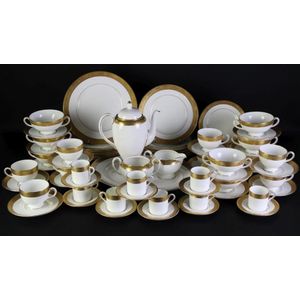
Wedgwood 'Ascot' Coffee/Dinner Service for Eight Persons
Wedgwood 'Ascot' Coffee/Dinner service for eight persons 1 x coffee pot & lid; 1 x oval form platter, width 36 cm; 1 x Leigh shaped creamer; 1 x sugar bowl, no lid; 8 x coupes; 8 x coupe saucers; 8, depth emitasse coffee cups; 8, depth emitasse coffee…
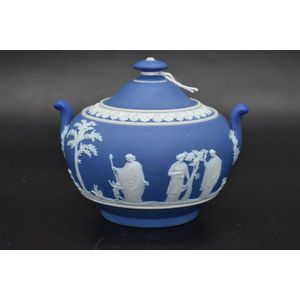
Grecian Scene Wedgwood Blue Sugar Bowl
Wedgwood blue jasper sugar bowl decorated with Grecian scenes c.1900, height 9 cm, diameter 10 cm

Wedgwood Polychrome Coffee Set, c.1900
A Wedgwood three piece coffee set c.1900 polychrome decorated in navy and gold comprising of a coffee pot, sugar bowl and cream jug impressed with Wedgwood marks and signature to undersides coffee pot, height: 18.5 cm

Wedgwood Tonquin Ruby Tea Service with Gilt Flowers
A Wedgwood 'Tonquin Ruby' tea service, red ground with gilt flowers, includes two dinner plates, cake platter, creamer, sugar bowl, soup bowl, six trios

Wedgwood 'Whitehall' Tea Set with Red and Gold Accents
A Wedgwood 'Whitehall' tea service, white ground, red stipple boarder, gilt ivy leaf rim, includes six trios, teapot, sugar bowl, creamer & cake platter

Wedgwood Coffee Service, Pattern No. 5260
A Wedgwood coffee service, includes coffee pot, six cups & saucers, milk jug & sugar bowl, pattern no 5260

Wedgwood Coffee Set with Gilt & Black Rim
A Wedgwood for Hardy Brothers coffee service, red stipple pattern with gilt & black rim, includes coffee pot, lidded sugar bowl, creamer, six demitasse cups & saucers

Wedgwood 'Medici' Dinner Set - Extensive Collection
Extensive Wedgwood 'Medici' dinner set including 13 dinner plates, 13 entree plates, 13 dessert bowls, 13 side plates, 8 soup bowls8 cups & saucers, 9 coffee cups & saucers, 2 milk jugs & sugar bowls, a lidded sugar bowl, lidded serving tureen and a…

Wedgwood 'Flying Cloud' Dinner Service
A Wedgwood 'Flying Cloud' dinner service, including nine dinner plates six bowls eight side plates six bread & butter plates eight deserts plates & nine side plates twelve small desert bowls nine cups & saucers two lidded tureens a platter & sugar bowl &…

Majolica Cabbage Leaf Cruet Set with Salt and Pepper
A Wedgwood Etruria & Barlaston Majolica cabbage leaf cruet set, salt, pepper & mustard pot, another salt & pepper

Wedgwood White Laurel Tea Set with Cobalt and Gold Trim
Wedgwood White Laurel patterned tea set, cobalt and gold trim consisting of 7 trios, milk jug, sugar bowl and cake plate.

Wedgwood Black Jasperware Coffee Service Set
Wedgwood black Jasperware coffee service, comprising coffee pot, creamer, sugar bowl, four demi tasses and five saucers, marked Wedgwood/Made in England, in matte black finish

Wedgwood 'Amherst' Dinner/Tea Service
Wedgwood 'Amherst' Dinner/Tea service in ivory white with pattern to rim. Comprising of 16 coffee cups, 16 teacups, 1 sugar bowl, 1 creamer, 15 soup cups, 1 gravy boat, 1 lidded tureen, 1 teapot, 1 coffee pot, 1 large serving tray, 1 small serving tray,…
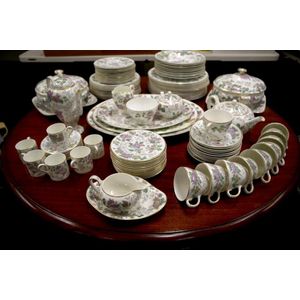
Wedgwood 'Avon' Dinner Set - 108 Pieces
Extensive Wedgwood 'Avon' dinner set 'Avon' pattern, # 3988, a total of 108 pieces, mainly settings for 12, including dinner plates, entree plates, side plates, and small tea plates, 10 soup bowls, 6 coffee cups and 7 saucers, 10 tea cups and 11 saucers,…

Wedgwood Belle Fleur Dinner & Tea Set
A Wedgwood blue Belle Fleur dinner, tea & coffee service, includes a teapot, coffee pot, gravy boat, sugar bowl, creamer, two tureens, six dinner, entree, side plates, bowls, soup bowls, coffee & tea cups with saucers

Wintergarden Queensware Dinner Set by Wedgwood
A Wedgwood Wintergarden Queensware dinner set, consisting of: 11 x dinner plates, 11 x entre plates, 22 bread and butter plates, 11 x pudding bowls, 9 x soup bowls, 13 x soup saucers, 11 x tea cups, 12 x tea cup saucers, 11 x coffee cups, 6 x coffee cup…

Floral Creamer, Sugar Bowl, Jar & Pin Dish Set
A pink floral Viennese creamer & sugar bowl + a Chilean lidded jar + a Wedgwood strawberry pattern pin dish [4]

19th Century Porcelain and Pottery Collection
Georgian Wedgwood black basalt coffee pot, Victorian salt glazed comport and pair of Continental porcelain figurines, 19th century, coffee pot 26 cm high

Wedgwood Flame Rose Dinner Service for 6
Wedgwood flame rose dinner service for 6 a beautiful suite made from bone china and features the stunning 'Flame rose pink flower pattern, Consists of 6 dinner plates, 6 entree plates, 6 dessert dishes, 6 trios and a sugar bowl. Total 37 pieces

Wild Strawberry Wedgwood Dinner Set for 8
Wedgwood 'Wild Strawberry' dinner setting for eight persons decorated in strawberry vine and comprising of coffee pot, sugar bowls (2), milk jug, cream jug, sweet dish, posy vase, 1 cake/pastries plate, 1 meat plate 8 coffee mugs, 8 teacups, 8 saucers 8…

Wedgwood Jasperware Set: Vases, Jug, Salt & Pepper, Plate
Seven Wedgwood Jasperware ceramics comprising 3 vases, jug, salt & pepper & a plate
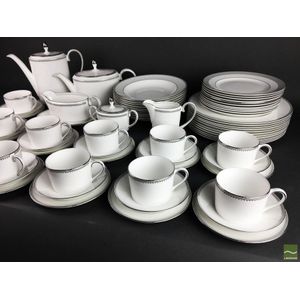
Vera Wang 'Grosgrain' Dinner Set for 12
Wedgwood Vera Wang 'Grosgrain' dinner setting for 12 consisting of 12 plates, 12 dessert plates, 12 large saucers, 12 smaller saucers, 13 bowls, 12 cups 2 teapots, 1 gravy boat, 1 sugar, 1 creamer

Wedgwood Vera Wang Grosgrain Dinner Set for 11
Wedgwood Vera Wang 'Grosgrain' dinner setting for 11 consisting of 11 plates, 11 dessert plates, 11 large saucers, 11 smaller saucers, 11 bowls, 11 cups 2 teapots, 1 gravy boat, 1 sugar, 1 creamer

Wedgwood Leedsware Creamware Tableware Set
Wedgwood Leedsware tableware Leedsware Classical Creamware collection, including teapot, 2 lidded sugar bowls, cream jug, pair shell form bowls, and 3 large serving plates.

Wedgwood 'Royal Lapis' Gilt Dinner Service
Wedgwood 'Royal Lapis' dinner service in the gilt pattern, with outer band in a symetrical pattern, consisting of 9 cups, 9 bowls, 9 dinner plates, 9 Desert plates, 9 saucers, 8 saucers, 9 small bowls, 1 sugar 1 creamer. Condition: Good-Some wear from use

Wedgwood 'Dolphins' Dinner Service (10 words)
A Wedgwood 'Dolphins' dinner service, includes twelve of each dinner, entree, side plates, bowls, teacups & saucers, coffee cups and saucers, a tureen, coffee pot, teapot, gravy boat & plate, sugar bowl & creamer. Stamped to base Dolphins R4652

Wedgwood Jasperware Tea Set in Blue and White
A Wedgwood blue & white Jasperware tea service, includes a teapot, sugar bowl & creamer, blue glaze with white detail

Wedgwood-signed Georgian-style Waterford Crystal Open Salt
Waterford Crystal Georgian style open salt, signed by Lord Wedgwood 1994, 9 cm high

Wedgwood 'Runnymede' Southern Cross Dinner Set
Twenty six piece Wedgwood 'Runnymede' dinner set, including coffee pot, 4 cups, 2 jugs, 2 sugar bowls, serving bowl, sauce jug and saucer, 7 soup bowls, and 7 dessert bowls. Each piece marked to base, and also marked 'Southern Cross,' (originally used on…

Wedgwood Black Basalt Silver Sugar & Cream Set
19th century Wedgwood black basalt sugar and cream silver shape

Cobalt Blue Dinner Set with Extras
Mikasa cobalt blue service for six, plus Maxwell sugar, Wedgwood bowl and Esse design mugs and bowls

Keith Murray Silver Plate Sugar Sifter
A modernist silver plate sugar sifter by Keith Murray Sheffield / Mappin & Webb /, circa 1934 the body tapered in form with reeded decoration, stamped Mappin and Web to base, 304 gms silver,16.5 cm high

Wedgwood Queensware Dinner Service for Eight
Extensive Wedgwood Queensware dinner service for eight, including two coffee pots, teapot, creamer and sugar, platters tureens, cups, saucers etc

1830 Wedgwood Black Basalt Lidded Sugar Jar
Lidded sugar jar, circa 1830 Wedgwood black basalt, height 8 cm

Wedgwood 'Blue Siam' 99-Piece Dinner Service
A ninety nine piece Wedgwood 'Blue Siam' dinner service, 1985-1998 production period, a complete setting for nine, comprising: dinner, entree, side plates, soup and dessert bowls, tea cups and coffee cans (ten) with associated saucers, coffee and teapots,…
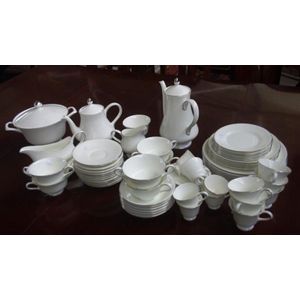
Wedgwood Silver Ermine Dinner Set
Extensive Wedgwood 'silver ermine' dinner set, comprising of 6 main plates, 5 entree plates, 6 side plates, 6 bowls, 6 tea cups & saucers, 6 coffee cups & saucers, 6 soup coupes & saucers, lidded tureen, gravy boat & saucer,coffee pot, teapot, sugar &…

Wedgwood Condiment Set, c. 1780
Wedgwood, cream ware condiment set, c. 1780, comprising salt, pepper and mustard pot, all impressed to undersides 'Wedgwood' (3), height 17 cm length 36 cm. Provenance: Alan Landis Antiques, Sydney. Collection of George and Adisa Pompei, Sydney

Wedgwood 'Silver Ermine' Dinner Set
Wedgwood 'Silver Ermine' dinner setting comprising six main plates, eight cups & saucers, eight bread & butter plates, eight soup cups with handles, a teapot, sugar bowl & cream jug

Victorian Wedgwood Porcelain Set with Queen Victoria's Grandchildren Design
Victorian Wedgwood porcelain items, including 2 cups & saucers & one sugar bowl. Octagonal form with orange design of Queen Victoria's grandchildren


 Loading more...
Loading more...